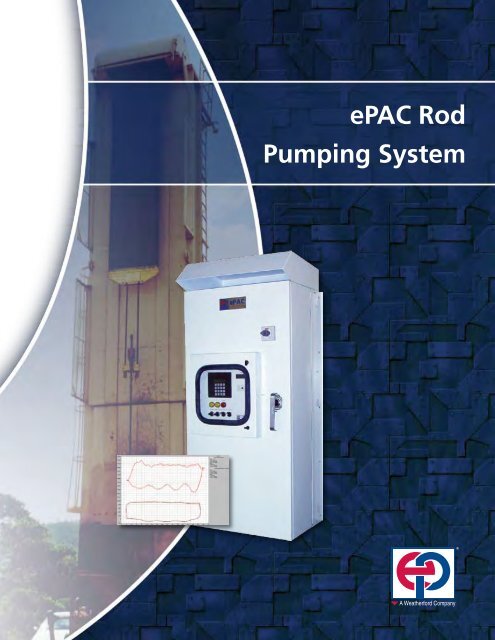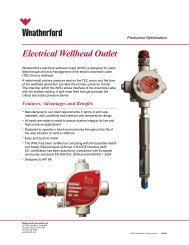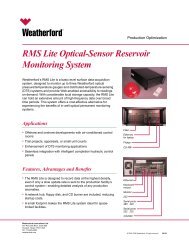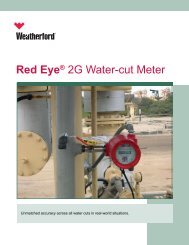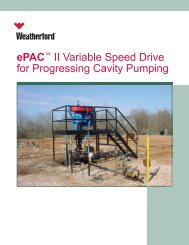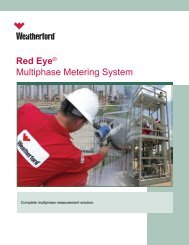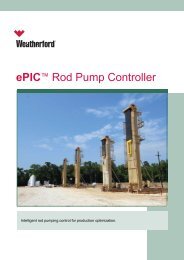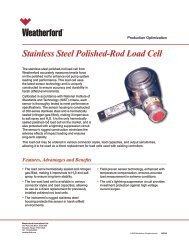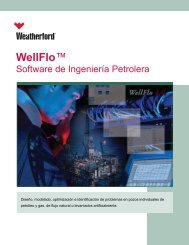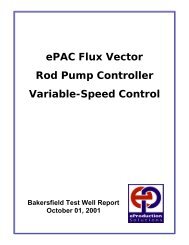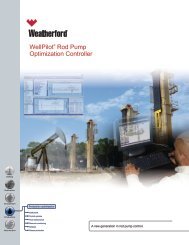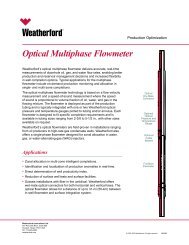ePAC Rod Pumping System - eProduction Solutions
ePAC Rod Pumping System - eProduction Solutions
ePAC Rod Pumping System - eProduction Solutions
Create successful ePaper yourself
Turn your PDF publications into a flip-book with our unique Google optimized e-Paper software.
<strong>ePAC</strong> <strong>Rod</strong><strong>Pumping</strong> <strong>System</strong>®A Weatherford Company
<strong>eProduction</strong> <strong>Solutions</strong>’ (eP’s) <strong>ePAC</strong> drive is specificallydesigned for oilfield pumping applications. The <strong>ePAC</strong> offersperformance enhancement beyond that of conventionalvariable frequency or variable speed drives as it incorporatesFlux Vector Drive (VFD) technology for the precision controlof both speed and torque. This improved control can aid theoptimization of electrically driven artificial lift systems.The <strong>ePAC</strong> has a proven track record of performanceenhancement with traditional pump jacks and long-strokepumping units such as the Weatherford Rotaflex. Theongoing development, deployment, and enhancement ofVFD technology can result in a higher economic returnfrom the operation of rod pumped wells.Why use an <strong>ePAC</strong>?eP’s <strong>ePAC</strong> drive can be used to improve pump performanceand well productivity in most oilfield rod pumpingapplications. The advanced control algorithm can increaseproductivity and extend the life of both new and existingartificial lift systems.The <strong>ePAC</strong> is able to deliver this functionality by providingprecise control of motor voltage, current, speed, andtorque. This provides continuous monitoring of operationalparameters and allows the <strong>ePAC</strong> to quickly adapt to dynamicdownhole conditions at all speeds.<strong>ePAC</strong> can further aid optimization by:• Automatically adjusting speed to match well inflowperformance• Offering infinite speed control• Providing independent up/down stroke speeds• Reducing total rod pumping system power consumption• Reducing rod parts• Offering a 20% increase in SPM over conventionallycontrolled units (Rotaflex)• Utilizing an integral tracker system that controls bridleseparation from the sucker rodThe <strong>ePAC</strong> overcomes the inefficient production problemsfound with the traditional control systems used for slowpumping in heavy oil applications. Precise torque andspeed control allow the system to operate at all speedswhile offering protection to the system.Cost Saving FeaturesAs a result of more efficient use of electrical power theuse of an <strong>ePAC</strong> drive will significantly reduce the lift costper barrel of fluid produced to surface as well as reducingmaintenance costs for the primary method of artificial lift.The high efficiency operation of the pumping unit can limitthe amount of stress placed on the rods during normaloperations and as a result of this can significantly reducethe number of repairs required during the life of the rodpumping system.• Uses high efficiency (92% - 96%) standard motors inplace of low efficiency (82% - 86%) high slip motors.• <strong>ePAC</strong> drives incorporate unique design features thatreduce electric utility costs and improve power quality.• The drives provide near-unity power factor at all speedsand loads, to avoid utility power factor penalties.• Gearbox torque limiter protects the gearbox fromexcessive torque loads, reducing the possibility ofgearbox damage.• <strong>Rod</strong> force limiter reduces the possibility of rod part.• Eliminates the high in-rush currents of across the linemotor starting.• Smoothes energy consumption by reducing excessiverod forces and counter balance errors.••••••••Reduces power consumptionMinimizes mechanical stress on equipmentEliminates excessive rod forceUses pump fill algorithms to optimize productionMaximum torque from 0 to base speedDoes not require external load cell inputAdjustable dynamic brakingIndependent up and down stroke speed
Performance FeaturesThe <strong>ePAC</strong> is designed to operate with 230, 380, 460, or575 Volt 50/60 Hz power sources. Units are also availablefor operation from single-phase power lines.• Minimum fill controller provides simple pump off controlof wells with poor inflow characteristics.• Gearbox ratio monitor automatically computes theoverall ratio between the motor and crankshaft witheach stroke of the pump.• Pump speed monitor provides instantaneous and averagepump speeds.• Independent operator-adjustable up and down strokingspeed set points.• Set point speed based on pump fill and feed back fromthe beam position sensor, that senses the direction ofthe polished rod.• Internal limit switch provides adjustable crank anglepoints for changing pump upstroke, downstroke, andcornering speed on Rotaflex jack pumps.• Integral tracker system controls separation of the bridlefrom the sucker rod.• Pump fill optimizer maximizes well production andeliminates fluid pound by independently adjusting upand down stroke speeds.• Heavy-gauge Nema 3R enclosures seal the <strong>ePAC</strong>electronics from environmental factors such as sand,moisture, and small organisms.• Optional graphic display for viewing real-time surfaceand pump cards.Operational ModesSingle SpeedIn single speed mode, the user sets one speed for theup and down stroke. The pump speed monitor uses themotor velocity and overall gear ratio to calculate both theinstantaneous and average pump speed.Dual SpeedDual speed control mode allows the operator to manuallyoptimize the performance of the well by adjusting both theup and down stroke speeds to the required speeds.OptimizeThe pump fill optimizer offers an advanced form of pumpfill control without the traditional requirement of separatedevices or control hardware.The <strong>ePAC</strong> automatically adapts to changing well inflowcharacteristics by adjusting up and down stroke speeds tomaximize well production while avoiding fluid pound.The pump fill monitor uses information from the motorand crank to determine pump fill percentage. Pump fill isdisplayed to the operator as a percent fill number and isused to automatically optimize well production.Automatic ControlThe <strong>ePAC</strong>’s embedded programming allows the user topreset limits to customize the control to the application.These controls are active in all operational modes andinclude:• Minimum and maximum SPM• Gear ratio monitor automatically computes the overall gearratio between the motor and the crankshaft each stroke ofthe pump and is used to monitor belt slip. Gearbox torquelimits can be preset to limit gearbox stress.• <strong>Rod</strong> force limiter reduces rod breaks by limiting themaximum stress that can be placed on the rods andas such increases rod life by reducing fatigue. It alsocan reduce rod compression damage by controllingthe minimum rod force. Maximum and minimum rodforces, and associated rod positions, are captured witheach stroke of the pump, and the rod force is adjustedautomatically to stay within preset parameters.• Bridle separation controller uses an internal calculationto detect loss of rod weight on the pump downstrokedue to rod float. The separation limiter automaticallyadjusts downstroke speed to track rod float whilemaximizing production.• Pump jack imbalance is displayed to the operator aspositive (overbalanced) or negative (underbalanced)crankshaft torque. Imbalance information allows theoperator to easily position or change the counterweightsto minimize gearbox stress and energy consumption.• The pump flow monitor uses well parameters and driveinformation to estimate pump flow. The estimated wellproduction is displayed to the operator in BPD.Control MonitoringUEDIT software allows the system to be monitored throughone of the <strong>ePAC</strong>’s serial ports. Various screens provideconfiguration and operational interfaces, including:• The dynagraph screen can be used to display bothsurface and pump card.• Data in the <strong>ePAC</strong> can be uploaded to an archive as abackup or downloaded to the drive from the archive torestore prior setup information.
User Interfaces• An operator interface provides access to systemparameters that are organized into logical groupings foreasy navigation.• On-line setup instructions, prompts, warnings, bargraph displays, and logical data groupings result in faststartups, smooth operation, and minimum downtime.• Pump fill monitor continuously measures and displaysthe pump fill percentage.• 16-button keypad allows simple menu navigation anddata entry.• 2-line by 24-character display provides easily readtext/graphics.• Optional graphics display available for viewing real-timesurface and pump cards.• Password protection is used to prevent unauthorizedaccess to drive parameters.• Fault log is used to capture time-stamped diagnosticinformation to aid in troubleshooting drive or pumpproblems.• Additional parameters that can be monitored include:• Input power monitor• Lift power monitor• Input power meter• <strong>Pumping</strong> efficiency• Production monitor• Pump cycle monitor• Balance monitor• Enhanced RTU protocol allows efficient transfer of both16- and 32-bit data through local or remote networks.Programmable Logic ControllerUEDIT also incorporates a Programmable Logic Controller(PLC) that can be used to monitor drive operation,customize the drive to unique system needs, and providea simple migration path for future upgrades.• Ladder Diagram Screen ~ Logic type signals can beprogrammed and monitored in familiar ladder diagramformats.• Function Block Screen ~ Analog type signals can bemanipulated and monitored using a rich variety offunction blocks.• Input/Output Screen ~ Input and output signals can beforced and monitored using a convenient I/O displaypanel.SpecificationsInput Voltage 230, 380, 460, or 575 Vac (±10%)Supply Frequency 47 to 63 HzPower Factor 1.00 displacement power factor; 0.94 overall powerfactor at all speedsOperating Temperature -40° to 122°F (-40° to 50°C)Storage Temperature 5° to 158°F (-15° to 70°C)Relative Humidity 5% to 95%, noncondensingAltitude 0 to 3,300 ft. (1,000 m) at full ratingAnalog Inputs Three 12 bit (±10 Vdc or 4 to 20 mA)Analog Outputs Two 12 bit (±10 Vdc and 4 to 20 mA)Digital Inputs Twelve (requires sink of mA to common)Digital Outputs Six (open-collector drivers rated 24 Vdc @ 500 mA)Serial Communications EIA RS-232 and RS-422/485, isolated, 0.3 to 19.2kbaudANSI-x3.28-2.5-A4, Allen-Bradley DF1, and ModiconRTU protocols®A Weatherford Company22001 North Park Dr.Kingwood, TX 77339Tel: 281-348-1000www.ep-solutions.cominfo@ep-solutions.comVisit www.ep-solutions.com for local sales,service, and support locations.<strong>eProduction</strong> <strong>Solutions</strong> products and services are subject to the Company’s standardterms and conditions, available on request. For more information contact an authorizedeP representative. Unless noted otherwise, trademarks and service marks herein are theproperty of eP. Specifications are subject to change without notice.©2002-2006 <strong>eProduction</strong> <strong>Solutions</strong>. All rights reserved. Rev. 03, 07/06


